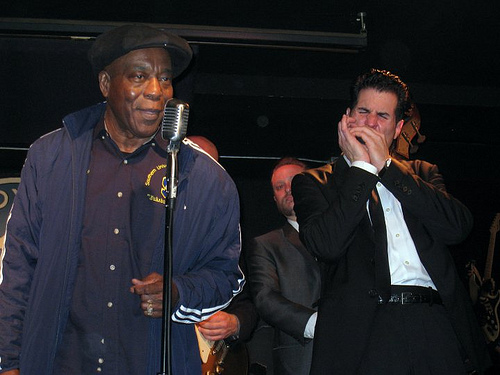Morry Sochat: The blues are hurting? Sez who? (photo: Andrew Leon)Try These Blues On For Size
By David McGee
EATIN’ DIRT
Morry Sochat & The Special 20s
Galaxie RecordsOn June 10, I was flying from New York to Las Vegas, en route to meet up with my sons and head for the bowels of Death Valley for a week. On the New York to Dallas leg of the flight, I read Charles Bowden’s chilling new book, Dreamland, about the unchecked slaughter in Juarez at the hands of drug gangs. Readers of last month’s issue know what became of that. On the Dallas to Las Vegas flight, a gent in front of me was reading that day’s Wall Street Journal. Peering over his shoulder, I noticed this headline on the page he was holding in front of him: “Lamenting the Future Of the Blues.” Reading the piece later, I found the reporter admitting he was “far from an expert on the blues,” before pronouncing the blues as being in a desperate state, based on all available evidence he had gathered at the Blues Foundation’s 31st annual awards gathering in Memphis in May. He says he heard all kinds of variations on the blues (“Delta blues, Texas blues, fast blues, slow blues…”) but no “new” blues. He took a quote from Buddy Guy out of context to prove that even the old masters are worried about the blues’s health these days, without ever mentioning that Guy’s 2008 album, Skin Deep, was one of the best albums of that year in any genre, along with B.B. King’s One Kind Favor and Elvin Bishop’s The Blues Rolls On, a title the WSJ reporter needs to take to heart. He quoted a Blues Foundation executive and an XM Satellite Radio host both opining about the no-no of messing with blues tradition. He lamented that a 2004 album by Little Axe, Champagne and Grits, “which mixed traditional blues with spoken word, drum loops, Indian percussion and a dab of reggae,” was ill-received by blues fans but is an example of how to attract more young listeners to the blues: “Give it to a Citizen Cope or a Massive Attack fan, and they’d feel at home.”
Buddy Guy sitting in with Morry Sochat & The Special 20s at the Eatin’ Dirt CD release party: Everything old is new again.To which I say: if a Citizen Cope or a Massive Attack fan likes the Little Axe album, well and good for Little Axe (aka Skip McDonald), but what the reporter describes ain’t the blues. The folly of this WSJ piece is that the reporter thinks contrivances such as drum loops and Indian percussion somehow bespeak a new frontier for the blues, a new coat of paint on the old model that can be credibly sold to a younger audience. Just a couple, three things wrong here. For one, the WSJ reporter never addresses the matter of content—the blues has its signature riffs and templates, but the reason the latest albums from Buddy Guy, B.B. King and Elvin Bishop rise above most everything else that came out in 2008 in any other genre is because their songs dare to address issues about getting through a day, a relationship, a life. No less an authority than Willie Dixon said it all when he observed: “The blues is about life; if it ain’t about life, it ain’t the blues.” Our WSJ naysayer never once mentions anything about what the artists he claims to have heard at the Blues Foundation event were really saying. For another, nowhere in his piece does he mention the influx into the blues of talented women, all of whom can write, play and sing with authority. Some of these artists have been profiled in this publication—Christine Santelli, Gina Sicilia, Dani Wilde, Lorrie Morvan—but there are many more in this category, most all of whom cut their teeth on the likes of Muddy Waters and Buddy Guy records, but as writers have been most influenced by Bob Dylan. In bringing new poetry to the language of the blues, these wmen can veer into singer-snogwriter territory without every losing the essence of the blues, because they got the Dixon Axiom right from the start. I’m betting the Wall Street Journal doesn’t even know any of these women exist, because its music writers, like those throughout the mainstream media, think the blues died when Stevie Ray’s helicopter smashed into the mountainside. Third, because the blues is about life, you can bet blues fans don’t want to mess with the tradition—they want the message to come through loud and clear. They want to know how an artist deals with a lousy relationship, or a bad day at work, or—if they cue up Jimmy Warren’s outstanding new album (No More Promises, reviewed in our June issue), or see Warren live, how Main Street is faring in these new hard times—you know, life, as Willie Dixon would know it.
On the other hand, if you want to know anything about the blues, why the hell would you go to the Wall Street Journal anyway?
Morry Sochat & The Special 20s, ‘My Baby,’ at Viva Las Vegas, April 3, 2010. Sochat (lead vocals, harmonica) is backed by Jim St. Marie (guitar), Mike Turturro (bass) and Bobby Trimble (drums).One thing for sure, Morry Sochat (pronounced “socket”) & The Special 20s Eatin’ Dirt is not going to pass the WSJ test of “new blues,” but it’s a terrific album for blues fans who aren’t snobs or are better informed than highbrow critics. Yeah, you can hear Muddy (and you don’t have to go far to do so—the searing title track opens the album with a familiar wailing riff, the electrified version of Robert Johnson’s National Steel howl), you can hear Buddy, you can hear some wailin’, honkin’, moanin’ Little Walter-style harmonica theatrics from Morry himself (on Junior Parker’s oft-covered “Mother-In-Law Blues,” and on the lowest of low-down laments, the grinding “Telephone Blues”), you can even hear the spirit of Chuck Berry tearing across the land in the rambunctious “Riot Up In Here,” which also happens to feature Doug Corcoran beating up an ol’ piano in such a way as to make Chuck’s nemesis, Jerry Lee, proud indeed. Guess what? It’s all good, fresh as the morning dew.
In his liner notes, Sochat makes no bones about how proud he is of Eatin’ Dirt. With good reason. Recorded live to tape in two days of sessions, the album captures Sochat and The Special 20s (with guests Billy Flynn, Dave Herrero and Brother John Kattke sitting in individually on three tracks) in heated form, working in a sizzling soundscape provided by producer Jimmy Sutton, who keeps the individual instruments and Sochat’s personable vocals immediate and dynamically rich, without letting one step on the other. As a live mix of a live recording, essentially, Eatin’ Dirt cooks from start to finish.
Morry Sochat & The Special 20s, ‘Riot Up In Here,’ from the new album, Eatin’ Dirt. Live at the Continental Club, Austin, October 9, 2009. Dave Wolfe (bass); Bobby Trimble (drums), Dave Ross (piano) and Jim St. Marie (guitar) are backing Sochat.Now, Sochat, who wrote nine of the dozen tracks here, is mainly focused on women and love—uh-oh, nothing “new” in that strategy—but he does dip his toe into topical waters on the shambling “Empty Pockets,” in which he sings of a hard working man who's broke but not broken, vowing to make life better for his woman—“if I save anything, baby, I’ll bring it home to you.” Herrero gets a star turn on the guitar solo here, and crafts a clever, richly textured statement out of starts, stops and sputters up and down the neck before bringing it home with an affecting, crying chord ahead of Sochat’s return. Mostly, though, Sochat is out for a good time, especially with the womenfolk. To that end he serves up a number of fine tributes to the distaff side: on a lively shuffle, “Someone to Love,” he does a nice job of playing the lonesome soul who’s decidedly broad-minded, you might say, about his companions as long as they honor the bottom line: “She can be young or old/rich or poor/long as they say, daddy, give me more, more more…” About halfway through Billy Flynn tears of a hot, serpentine guitar solo and Shoji Naito shadows him with some astute rhythmical variations on harmonica. When he’s actually got a woman, Sochat is positively euphoric—we get the message in the sunny jump blues of “Apple Of My Eye,” when our man can hardly contain his enthusiasm over the multitude of physical perfections he finds in his main squeeze; even his rousing, sputtering harmonica solo bespeaks the intensity of his affection.
So later for the Wall Street Journal, and don’t worry about the blues. Morry Sochat & The Special 20s are taking care of business, and so are a bunch of younger, equally inspired artists, male and female alike. In these hands the blues will survive and thrive, and will be there when fans of Citizen Cope, Massive Attack or Lady Gaga hunger for the real thing. Then we’ll see exactly who’s eatin’ dirt.
Morry Sochat & The Special 20s’ Eatin’ Dirt is available at www.amazon.com.
THE BLUEGRASS SPECIAL
Founder/Publisher/Editor: David McGee
Contributing Editors: Billy Altman, Laura Fissinger, Christopher Hill, Derk Richardson
Logo Design: John Mendelsohn (www.johnmendelsohn.com)
Website Design: Kieran McGee (www.kieranmcgee.com)
Staff Photographers: Audrey Harrod (Louisville, KY; www.flickr.com/audreyharrod), Alicia Zappier (New York)
E-mail: thebluegrassspecial@gmail.com
Mailing Address: David McGee, 201 W. 85 St.—5B, New York, NY 10024
Founder/Publisher/Editor: David McGee
Contributing Editors: Billy Altman, Laura Fissinger, Christopher Hill, Derk Richardson
Logo Design: John Mendelsohn (www.johnmendelsohn.com)
Website Design: Kieran McGee (www.kieranmcgee.com)
Staff Photographers: Audrey Harrod (Louisville, KY; www.flickr.com/audreyharrod), Alicia Zappier (New York)
E-mail: thebluegrassspecial@gmail.com
Mailing Address: David McGee, 201 W. 85 St.—5B, New York, NY 10024



